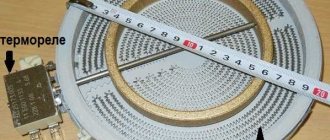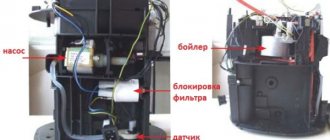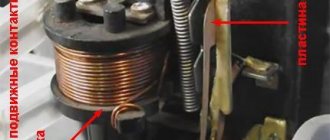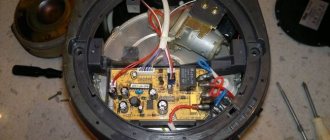Previously, gas stoves were produced without electric ignition. In fact, this is not a mandatory function, but its appearance makes the process of using a household appliance much easier: there is no need to buy a special lighter or matches. However, over time, the function often fails. Let's figure out what to do if the electric ignition device on a gas stove does not work and whether it is possible to fix the problem yourself.
Burner with electric ignition
Symptoms of a problem
Electric ignition on gas stoves can break unexpectedly: the switch turns, gas comes out, but there is no spark. A breakdown of an additional function can occur for completely different reasons.
But first of all, it is worth determining that the electric ignition function of the gas stove has actually failed. The following signs may indicate this:
- when pressing the control knob or burner button, the electric ignition function does not work;
- The automatic functions of the device operate in continuous mode, sounds similar to clicks are noted. In this case, there is no spark, the gas stove simply does not ignite;
- when the handle or button is released, the system does not turn off;
- the device operates even without pressing the button;
- there is a knocking out of the circuit breaker in the area of the apartment panel when the device is turned on;
- the presence of a malfunction can be determined using the piezo ignition and electric ignition circuit; it can be closed.
The main advantages and features of stoves with electric ignition
Naturally, not everyone needs such a function as electric ignition. Many people still use matches or a lighter to light the burners. At the moment, it is unlikely that you will be able to find a stove that does not have an electric ignition function. But there's nothing wrong with that. Prices for stoves with and without electric ignition are practically the same.
You may be interested in: How to properly install a dishwasher?
In fact, a stove with electric ignition has several advantages:
- You don't have to run around looking for matches or a lighter to turn on the gas. Moreover, this technique is very easy to use.
- There is no way you can get burned while lighting the burner.
- If you have used an electric stove for quite a long time, then the process of getting used to gas appliances will be more painless for you. You simply need to press a button or, as in the case of automatic electric ignition, turn a switch.
How the function works
An electric ignition system is provided in gas-type stoves. Its main purpose is to ignite the fuel that comes from the burner divider. The electric ignition device can be of two types:
- automatic;
- mechanical.
Auto-ignition has special piezoelectric elements, which, when turning the switch on the panel, ignite the gas-air mixture. When using a mechanical device, you need to press a special button. When pressed, a spark is generated, which ignites and ignites the gas.
The operating principle of electric ignition looks like this:
- when the user presses the button, voltage is applied to the capacitor area;
- after this, charging of the capacitor begins;
- then there is an increase in the level on the thyristor;
- as soon as it reaches the permissible limit, the capacitor begins to discharge;
- a voltage appears at the output of the device, due to which the spark gap is activated;
- the spark released ignites the gas.
Electric ignition operation
Although the process looks complicated, it happens in a matter of seconds. The spark always hits the area of the burner that is on at that moment. In outdated products, a spark was supplied to all burners, but ignition occurred only on the one on which the gas supply was open.
The electric ignition is powered from an electrical network with a voltage of 220 volts. Its operation also depends on voltage surges, which can occur quite often. If a power surge occurs, a clicking sound may occur, which usually indicates a faulty ignition device.
High voltage unit design
What is electric ignition and its types?
Electric ignition is a very convenient feature that allows the user to safely light a gas stove burner without getting burned. The gas is ignited from a piezoelectric element or from an electric candle. According to this principle, electric ignition is divided into two types:
- Mechanical - after turning the burner handle, you must press the start button so that the gas-air mixture ignites.
- Automatic ignition is more convenient, since in order to ignite the gas in the burner, you only need to turn the knob.
Today, all gas stoves sold in hardware stores have mechanical or automatic ignition. They have many advantages over older models that are lit with matches or hand lighters:
- the possibility of getting a burn is excluded;
- no need to look for a lighter or matches on sale;
- the process is quick and convenient—one or two manipulations are enough to ignite.
The disadvantage of the electric ignition unit for a gas stove is its dependence on electricity. If there is a power outage, you will have to resort to matches.
…
Causes of failure
Many owners of household appliances often have a question: why did the electric ignition stop working? Failure of this function can occur for various reasons, among which it is worth highlighting:
- no spark at the electrodes;
- moisture or grease has reached the surface of the internal part of the system or the spark plug;
- breakdown of the electric ignition can occur due to the appearance of a crack or due to damage to the insulation of the ceramic base candle;
- The transformer, the spark generation unit, burned out. Usually, when you press the button, there is no spark. You can do it yourself, but experts recommend replacing the part with a new one;
Checking the spark generation unit - the presence of oxidation of the contacts of the power button or the appearance of a layer of soot on them, which was formed as a result of a short circuit.
Sometimes minor malfunctions can appear as a result of wet cleaning of the hob. This usually occurs due to moisture getting into the interior of the appliance. To eliminate everything, it will be necessary to take preventive measures: clean the contacts, dry the spark plugs. All these actions can be carried out by any user without knowledge and experience in this matter.
Malfunction may occur when cleaning wet
It happens that only one burner does not light. This may occur due to a malfunction of the high-voltage wire that goes to the ignition electrode. The ignition device itself may break down, or the block channel may fail.
Breakage can sometimes occur when cleaning the burner
Electric ignition does not work on one burner
Most gas stoves are designed in such a way that a person does not have contact with open fire. The practicality of automatic ignition is explained by the fact that it is easy to use: all you need to do is turn on the button that is specifically designed for this. But the following problem may arise - the electric ignition does not turn on on one burner. What to do then?
If the ignition does not turn on when the button is pressed, or clicks are heard but there is no spark, it means that the device is not working properly. If all the burners are working properly and only one does not turn on, the problem may be in the high-voltage wire. It is supplied to the ignition device, and disturbances in it lead to interruptions. The cause may also be a breakdown of the ignition device or damage to the entire auto-ignition unit.
The most common cause of interruptions in the operation of one burner is contamination of the nozzle nozzle. When cooking food, food residues could get there, which interfere with the flow of gas. To fix the problem, you need to clean or replace the nozzle.
The problem of one non-working gas stove burner may be a breakdown of the gas control system. In this case, the flame flares up and goes out immediately after the button is released. The repair consists of replacing the thermocouple, electromagnetic button or the entire gas control mechanism. Its complexity depends on the degree of damage.
The gas valve on the stove may not turn properly. This is also one of the reasons for poor gas supply and poor combustion. The faucet handle becomes clogged with carbon deposits, particles of debris and dust. It should be lubricated, cleaned and turn well.
Repair features
You can repair the electric ignition device yourself, but you must first conduct a thorough inspection of the device. It is important to first establish the cause of the breakdown and the degree of complexity. If the problem is simple, you can fix it yourself.
Ignition button
If the electric ignition function does not work well, the repair process is usually performed the same for all models of household products. All gas stoves have this function in a standard way.
It is advisable, before starting the repair process, to carefully study the structure of the stove: you can find information on the Internet or study the attached instructions for use. If you know how the device works, this will help you perform high-quality and correct repairs.
Electric ignition unit
Repair of electric ignition depends on the type of failure. To understand how it is produced, it is worth considering the types of breakdowns and their elimination:
- The burner should be lit using matches or a special lighter. Carefully examine the appearance of the flame: it should be even, light, and spread over the entire circumference of the divider. If a yellow color is observed, this will indicate an incorrect gas-to-air ratio. To fix this problem, you need to clean the nozzle or completely replace it. Perhaps the cause of the malfunction is that the divider holes are clogged or there is moisture in them. It is also advisable to take preventive measures: blow out all the holes, remove the burner body and carefully examine it;
Normal flame - Usually all electrodes and switches are connected in parallel. Each electrode is powered from a single ignition unit, but they are turned off and on using different buttons. In order to establish that this particular button has stopped working, and the control unit is in normal condition, you need to check the next burner. If the gas catches fire, the button needs to be repaired. It turns out that the remaining elements in the device are in good condition;
- Sometimes there may be a crackling sound in the ignition system. In these cases, it is recommended to check the contacts. This problem can arise when they stick due to a coating of fat, and a layer of soot may appear on them, which negatively affects the work. Before carrying out repairs, the stove must be disconnected from the network, then disassembly is required. All contacts should be thoroughly cleaned or dried using a regular hair dryer. However, you must follow the established safety requirements to help avoid dangerous injuries.
DIY electric ignition for a gas stove
Do-it-yourself electric ignition repair
Malfunction and repair of internal combustion engine camshafts.
The most common failures of this part are breakage of the cams, bending of the camshaft, wear of its bearing journals, as well as an increase in bearing clearances. All these malfunctions are usually indicated by a knocking sound from the valve mechanism, as well as a decrease in oil pressure.
The bearing clearance can be returned to normal by restoring or regrinding the shaft journals to the nearest repair size. In this case, the depth of the oil grooves should be increased to prevent oil starvation of engine parts. After completion, the necks must be polished using GOI paste
If the shaft cams are slightly worn, they can be restored by sanding them. In this case, it is necessary to switch from coarse-grained paper to fine-grained paper. If the cams have crumbled in some places, it is recommended to remove the sharp edges of the metal with the same sandpaper. However, this will only help in case of small chipping (up to 3 mm in length). Otherwise, you will have to purchase a new assembly assembly. In case of vertical wear of the cams, complex grinding on a copy grinding machine is necessary. In the case of significant vertical excavation, the cams are repaired by welding. Then they should be sanded. Note that the permissible development of the cams is 0.5 mm. At higher values, a decrease in the power characteristics of the power unit is observed. Therefore, in such cases, the shaft is replaced with a new one.
Worn camshaft journals are also repaired by welding. Although there are other restoration methods - chrome plating and stagnation. But in any case, the restored parts must be polished.
As mentioned above, the shaft can also have a bend. Its permissible value is no more than 0.1 mm. Otherwise, the part will need to be repaired.
You should also measure the gap between the shaft journals and the holes in the supports on the block head. Measurements are made using calibrated wire. In this case, its maximum value can be 0.2 mm.
I need a drawing I don’t have
Modern gas stoves or gas hobs are equipped with electric ignition. Having studied the principle of operation, you will have a chance to repair the electric ignition with your own hands . The electric ignition of gas stoves and hobs is turned on by rotating the gas supply knob to the selected burner or by briefly pressing the electric ignition button. You hear a click generated by the discharge of the electrode to the ground of the burner. At this moment you can see a spark, something like lightning, but in miniature. And people with a heightened sense of smell can smell ozone.
Discharge after discharge follows at intervals of one second, until the gas handle is released. If you have an electric ignition button, the number of electric ignition discharges is equal to the number of presses on the electric ignition button. Accordingly, the frequency of discharges in manual mode is equal to the frequency of pressing the button. The discharge causes ignition (ignition) of the incoming gas into the selected burner. But since the circuit for producing a spark works from the mains (electricity), ignition acquired the name electric ignition. In the case when sparking occurs automatically, such electric ignition is also called electronic.
THERE ARE TWO ELECTRIC IGNITION OPTIONS:
- By pressing and releasing the electric ignition button, a single spark occurs (at the moment the button is released).
- By pressing the gas supply knob on the burner, continuous sparking occurs at intervals of one second.
- Valera
- Off site
- Regular
- Posts: 219
TWO ELECTRIC IGNITION OPTIONS ARE BASED ON TWO ELECTRICAL DIAGRAM OPTIONS:
1. The first option (Fig. 3) is based on the manual charge-discharge mode of the storage capacitor. It works like this:
(r1- 3.9k, c1- 2.2 MkfX600V, d1- 1N4007) The circuit is connected as follows: The diode d1 is supplied with mains voltage (Fig. 3.1). By pressing the electric ignition button, you apply mains voltage to capacitor c1 (Fig. 3.2). The capacitor is charging. At the moment the button is released, the contact of the capacitor c1 (Fig. 3.2) is connected to the transformer t1, through the contact (Fig. 3.3). The reverse process occurs - the discharge of the capacitor through the primary winding of the high-voltage transformer t1. On the secondary winding of the transformer (Fig.3.t1-1) and (Fig.3.t1-2) an output voltage of about 10 kilovolts is formed. A spark is formed. By pressing and releasing the button the process is repeated. The transformer terminals (Figure 3.t1-1) and (Figure 3.t1-2) in (Figure 1 and Figure 2) are designated number 1. The terminal (Figure 3.1) corresponds to numbers 5 and 2 (Figure 2). The output (Fig. 3.2) corresponds to numbers 7 and 3 (Fig. 2). The output (Fig. 3.3) corresponds to numbers 6 and 4 (Fig. 2).
2. The second option (Fig. 4) is based on electronic control of the charge-discharge mode of the storage capacitor. It works like this:
(r1- 300 ohm, c1- 2.2 MkfH600V, d1- 1N4007, d2- 1N4007, d3- 1N4007, r2-1.5 kΩ, r3-30 kΩ, s1- ku202n, )
When you press the electric ignition button, charge and discharge occur automatically. The automatic mode depends on the electrical ignition circuit design.
The circuit works as follows: with a positive half-wave of the mains voltage, capacitor C1 is charged through D2 and D3, with a negative half-wave through D1, the cathode S1 is connected to the “minus” half-wave, and through resistor R3 the control current is supplied to the control electrode of the thyristor. The thyristor opens, capacitor C1 is discharged into the high-voltage transformer, which induces an ignition spark. An output voltage of about 10 kilovolts is formed on the secondary winding of the transformer. By holding the gas handle down, the process is repeated at a frequency of 50 Hz, or roughly one spark per second.
Electrical ignition is more common with four and six channels (Fig. 1 and Fig. 2), number 1 indicates taps for connecting the electrodes on which you observe sparking. In other words, we have four ignition electrodes or six electrodes. The number of electrodes depends on the number of secondary windings of the step-up transformer. If there are two windings, therefore we have four outputs to four electrodes. If there are three windings of the step-up transformer, we have six outputs for six electrodes.
Electric ignition, which allows you to connect six electrodes, is usually used in gas stoves of the same design as an oven. And as a result, two of the six electrodes available are in the oven and are used to ignite the gas in the oven. The appearance of electric ignition devices can be seen in (Fig. 1 and Fig. 2). They have some differences, but the circuit design and operating principle remain unchanged.
Below is a list of common malfunctions of electric ignition of gas stoves, and methods for eliminating them. This information accumulated over years of practice and acquired structural forms. The information will be useful for both novice craftsmen and those who are used to repairing everything with their own hands. Below is a list of six points that characterize the malfunction of the electric ignition of gas stoves. Knowing the contents of the items will help you more easily understand the secrets of repair. Each item contains a detailed description of the logical ways to troubleshoot the item name. Knowledge will help you repair the electric ignition of gas stoves with your own hands . Carry out repairs yourself.
© studopedia.ru Is not the author of the materials posted. But it provides free use. Is there a copyright violation? Write to us. ip: 109.195.95.109
Radio circuits Electrical circuit diagrams Multi-spark ignition for a gas stove
Almost all gas stoves have a gas ignition system . When you press the button, a spark gap is triggered near the burner, a spark strikes and the gas ignites. Of course, this is very convenient (after all, once upon a time this whole procedure had to be carried out using matches), but there is one drawback here - the spark produced by this device is single.
By using electronics, you can slightly modify this system and turn it into a multi-spark system.
Schemes for igniting gas in household gas stoves
The circuit has been used by the author for more than 10 years as an electric ignition Indesit and is mounted within the dimensions of a “standard” device. The high-voltage transformer in this design is a “native” one, but if you don’t have one, you can try to make it yourself (for a four-burner stove, there are two transformers). The transformer is wound on a core made of transformer steel plates with a cross-section of about 1 cm2 (a set of “closing plates from a W-shaped transformer). For winding, a frame is made from pressboard, thick cardboard or textolite (preferably sectional, with cuts in sections) or a suitable plastic frame is taken from an W-shaped transformer. The primary winding contains 10.20 turns of PEV-2 0.8 wire, and the secondary winding is wound with PELSHO 0.07 wire and contains several thousand turns - until the frame is filled. Winding is carried out with a roller from one edge of the frame to the other, so that the high-voltage terminals are on opposite sides of the frame. The secondary winding is carefully insulated from the primary winding with several layers of wax paper, lavsan or fluoroplastic film. The entire structure is impregnated with ceresin to improve insulation. The circuit works as follows: with a positive half-wave of the mains voltage (pin L), diode VD2 alternates with charging capacitor C1, and with a negative half-wave, triac VS1 opens through diode VD1 and discharges capacitor C1 to a high-voltage transformer, which forms an ignition spark . The process is repeated with a frequency of 50 Hz and a powerful sheaf of sparks is formed on the ignition electrodes, instantly igniting the gas.
This circuit for electrically igniting gas for a household gas stove is almost similar to the one shown above, but contains a little more details - here a thyristor is used instead of a triac. The circuit works as follows: with a negative half-wave of the mains voltage (pin L), capacitor C1 is charged through diodes VD2 and VD4, and with a positive half-wave, thyristor VS1 opens through diode VD1 and discharges capacitor C1 to a high-voltage transformer, which forms an ignition spark. Diode VD3 serves to ensure the flow of current through the control electrode of the thyristor at a positive half-wave. The process is repeated with a frequency of 50 Hz and a powerful sheaf of sparks is formed on the ignition electrodes, instantly igniting the gas.
The circuit works as follows: with a positive half-wave of the mains voltage (pin L), capacitor C1 is charged through diodes VD2 and VD3, and with a negative half-wave, through diode VD1, the cathode of the thyristor VS1 is connected to the “minus” half-wave, and through resistor R3 the control electrode of the thyristor receives control current. The thyristor opens and discharges capacitor C1 to the high-voltage transformer, which forms an ignition spark. The process is repeated with a frequency of 50 Hz and a powerful sheaf of sparks is formed on the ignition electrodes, instantly igniting the gas.
All about washing machine repair
Before playing with sparks, you should know that high voltage is dangerous to life and, in addition, each spark is a source of the entire range of radiation, including radioactive ones. Most modern gas appliances use an electronic device that ignites the gas, here are a few from stoves
I became interested in these devices with the goal of making a homemade lighter based on them or using this scheme, due to the lack of normal electric lighters for stoves on sale. It turned out that this is not such a complex device as it seems at first glance. It is enough to apply 220V to the terminals marked with the letters “L” and “N” and high-voltage pulses will appear at the coil terminals, approximately 10 kV from each coil. To avoid damaging the device, it is necessary to place jumpers between the terminals of the coils so that the total clearance between the terminals of each coil is no more than 10 mm. Like on a picture.
From such a device you can make a separate lighter that runs on mains power. It is not worth building it into the stove, since modification and modernization of gas appliances is not a rewarding and very dangerous task.
Here is an approximate electrical ignition diagram.
I assembled it on a triac VT138 R1=100R 2w, R2=22k 0.25w, R3=1k 0.125w, C=3mf, on ring ferrite (8 turns of primary, 50 turns of secondary). It produced sparks with a frequency of approximately 50Hz, which could not penetrate 1mm of air. You need to wind the transformer on a rod core and on a special frame or buy a ready-made device. And so, when the turns of the primary were reduced, the strength of the spark weakened, and then the triac burned out with two turns. ———— I found a wiring diagram for the tor220-227 microcircuit, it is very similar to the ignition circuit
here the field-effect transistor works for the primary, but for some reason it is connected in series. When using a microcircuit, 300V pulses are supplied to the primary if you wind two secondary windings, one for feedback and the other boosting, the output of which can be connected to a multiplier, the output of which can spark.
It seems there should be a lighter circuit that is more reliable and simpler. Who knows, tell me.
- Replacing an socket with your own hands Replacing an socket is necessary in cases when the old one stops performing its functions or is simply broken.…
- Decorating doors with your own hands Decorating interior doors with your own hands: ideas You are not going to spend a large amount, but want to refresh...
- Do-it-yourself installation of fire protection for an air duct Before you begin installing fire protection for an air duct, you need to complete preparatory work. All duct flange connections...
- Repairing a toilet cistern with your own hands It’s good when everything works properly, but what to do if one fine day you…
When to contact a specialist
To repair electric ignition, you do not need to have much experience and knowledge; even inexperienced users can handle it.
However, sometimes it is necessary to conduct a thorough check and diagnostics of the device. You certainly won’t be able to do this with a flashlight and a simple screwdriver. For this reason, it will be necessary to call a specialist. Of course, the services of a specialist can be expensive, but sometimes a breakdown of the electric ignition can occur as a result of a serious reason that can pose a threat to humans.
Sometimes repairs should be left to professionals
In any case, before you start repairing the electric ignition device, you should carefully study the device diagram. This will help fix the problem much faster, without damaging the device. It is important to check the combustion first; sometimes it may be a problem with the burner or other components.
All about washing machine repair
Before playing with sparks, you should know that high voltage is dangerous to life and, in addition, each spark is a source of the entire range of radiation, including radioactive ones. Most modern gas appliances use an electronic device that ignites the gas, here are a few from stoves
I became interested in these devices with the goal of making a homemade lighter based on them or using this scheme, due to the lack of normal electric lighters for stoves on sale. It turned out that this is not such a complex device as it seems at first glance. It is enough to apply 220V to the terminals marked with the letters “L” and “N” and high-voltage pulses will appear at the coil terminals, approximately 10 kV from each coil. To avoid damaging the device, it is necessary to place jumpers between the terminals of the coils so that the total clearance between the terminals of each coil is no more than 10 mm. Like on a picture.
From such a device you can make a separate lighter that runs on mains power. It is not worth building it into the stove, since modification and modernization of gas appliances is not a rewarding and very dangerous task.
Here is an approximate electrical ignition diagram.
I assembled it on a triac VT138 R1=100R 2w, R2=22k 0.25w, R3=1k 0.125w, C=3mf, on ring ferrite (8 turns of primary, 50 turns of secondary). It produced sparks with a frequency of approximately 50Hz, which could not penetrate 1mm of air. You need to wind the transformer on a rod core and on a special frame or buy a ready-made device. And so, when the turns of the primary were reduced, the strength of the spark weakened, and then the triac burned out with two turns. ———— I found a wiring diagram for the tor220-227 microcircuit, it is very similar to the ignition circuit
here the field-effect transistor works for the primary, but for some reason it is connected in series. When using a microcircuit, 300V pulses are supplied to the primary if you wind two secondary windings, one for feedback and the other boosting, the output of which can be connected to a multiplier, the output of which can spark.
It seems there should be a lighter circuit that is more reliable and simpler. Who knows, tell me.
Source











